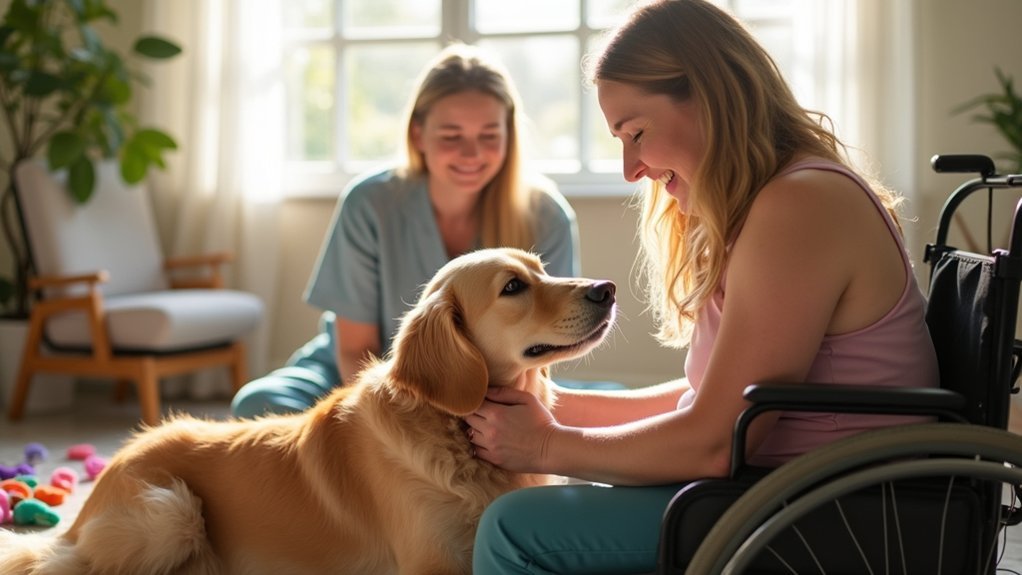Animal-assisted therapy provides powerful benefits for spinal recovery patients. Interactions with dogs can improve your core strength through walking and play activities, while equine therapy mimics natural pelvic motion to enhance balance. These animal bonds release mood-boosting hormones that reduce stress and pain while combating isolation. You’ll find both physical and emotional healing through structured rehabilitation programs featuring therapy animals. Discover how these remarkable partnerships can transform your recovery journey.
The Science Behind Animal-Assisted Therapy for Spinal Patients

While conventional rehabilitation focuses on physical exercises and medication, Animal-Assisted Therapy (AAT) offers a complementary approach that addresses both physical and emotional aspects of spinal recovery.
Research shows that interacting with therapy animals can greatly reduce stress levels and provide modest pain relief during recovery. You’ll likely experience mood improvements, particularly during initial sessions, as the animals help diminish negative emotions.
Therapy animals reduce stress and ease pain while brightening mood during the challenging journey of spinal recovery.
The sensory stimulation provided by therapy animals enhances your engagement in rehabilitation activities and helps you express feelings that might otherwise remain bottled up. This interaction contributes to improved self-esteem, creating a positive feedback loop that supports recovery. Activities designed with AAT dogs include reaching, petting, and walking with them to promote enhanced mobility skills during rehabilitation sessions.
AAT isn’t designed to replace traditional therapies but rather to enhance them within a structured multidisciplinary approach, offering emotional benefits that complement physical rehabilitation.
How Dogs Support Mobility and Core Strength Development
Dogs play a remarkable role in mobility rehabilitation for spinal patients beyond their emotional support benefits. When you interact with therapy dogs through petting or walking exercises, you’re actively engaging core muscles essential for stability and recovery. These canine companions create motivation that traditional therapy often lacks. This rehabilitation approach can benefit many of the 265,000 Americans currently living with spinal cord injuries.
| Activity | Benefit | Patient Experience |
|---|---|---|
| Walking therapy dogs | Core muscle engagement | “I forgot I was in therapy” |
| Interactive play | Fine motor skill development | “My hands moved without pain” |
| Balance exercises with dogs | Proprioception improvement | “I felt steady for the first time” |
Using supportive devices like harnesses alongside canine interaction provides both physical and emotional rehabilitation benefits. Your therapist might incorporate a dog into occupational therapy sessions, creating an activity-based approach that strengthens muscles while reducing stress and pain during your recovery journey.
Equine Therapy: Benefits of Horses in Spinal Rehabilitation

Equine therapy offers remarkable benefits for spinal rehabilitation that complement traditional treatment approaches. The horse’s rhythmic, three-dimensional movement mimics human pelvic motion, improving your balance, posture, and muscle strength while correcting abnormal gait patterns.
You’ll find this therapy particularly effective for spinal cord injuries, multiple sclerosis, and chronic low back pain. The repetitive swinging motion encourages lumbar movement and stretching, potentially shortening your recovery time. Recent research at the University of Eastern Finland demonstrated significant pain reduction among participants in equine-facilitated therapy over a 12-week intervention.
Beyond physical benefits, you’ll likely experience psychological improvements too. Interacting with horses boosts self-esteem, promotes emotional growth, and provides stress relief.
These sessions, conducted by certified therapists in accessible facilities, create opportunities for social interaction while delivering immediate improvements to your mental well-being.
Mental Wellness and Emotional Recovery Through Animal Bonds
Beyond the physical rehabilitation benefits of animal therapy, the emotional bond you develop with animals can profoundly impact your mental wellness during spinal recovery.
When you pet an animal, your body triggers an automatic relaxation response that reduces stress and anxiety—crucial during challenging rehabilitation periods.
This human-animal connection isn’t just comforting; it’s therapeutic. A remarkable 86% of Americans report that their pets positively affect their mental health. Studies consistently show that animal interactions release oxytocin and serotonin, promoting relaxation while lowering your blood pressure during recovery.
During therapy sessions, animals serve as catalysts, increasing your engagement while creating a safe space for emotional expression.
The companionship animals provide helps combat isolation and loneliness often experienced during recovery. They become part of your support network, enhancing emotional resilience and helping you navigate difficult emotions.
This bond creates a foundation for healing that extends beyond physical rehabilitation.
Practical Activities: Integrating Animals Into Rehabilitation Programs

When integrating animal therapy into your rehabilitation program, specific activities can greatly enhance recovery outcomes.
Try mobility exercises like reaching to pet therapy dogs or walking alongside them to improve your core strength and range of motion. For fine motor skill development, engage in therapeutic tasks such as placing clips in a dog’s hair or draping necklaces over its neck.
These animal interactions provide valuable sensory stimulation while encouraging emotional expression in a supportive environment. Therapy dogs can complement your occupational, physical, and speech therapy sessions by making exercise more engaging.
Therapy animals create safe spaces for emotional healing while making critical rehabilitation exercises feel like meaningful connection.
The presence of therapy dogs has shown to reduce isolation feelings among patients, fostering a sense of connection during the rehabilitation journey.
Programs like Animals Heal Hearts and Canine Therapy Corps offer structured sessions with specially trained and screened dogs. You’ll likely experience reduced stress, better pain management, improved mood, and enhanced self-esteem through these therapeutic animal interactions.
Success Stories: Transformative Journeys With Therapy Animals
The power of animal-assisted therapy reveals itself most vividly through countless success stories of spinal recovery patients.
You’ll find inspiration in cases like Toston, the basset hound who regained full walking ability after spinal surgery and underwater treadmill therapy, or Ralph, the Clumber Spaniel who progressed from paralysis to running independently.
These transformations aren’t just physical. Patients experience reduced anxiety and depression while working with therapy animals, showing increased motivation during challenging exercises.
When you’re struggling with a life-altering spinal injury, even small improvements become meaningful milestones.
Clinical settings report that therapy dogs greatly decrease patient stress while improving engagement in rehabilitation activities.
Early, consistent therapy combined with the emotional support of animals creates a powerful healing environment that transforms both body and spirit.
Dr. Sanchez and her well-trained team create individualized treatment plans based on thorough assessments to ensure optimal rehabilitation outcomes for each animal.
Building Your Support Team: Finding the Right Animal Partners

Finding the right animal partners for your spinal recovery journey involves careful consideration of multiple factors that greatly impact therapeutic outcomes.
Your spinal recovery demands thoughtful animal partnerships—each choice significantly influences your therapeutic journey’s success.
Dogs are popular choices due to their loyalty and bonding abilities, but any potential therapy animal should have a calm temperament and nonjudgmental nature.
When selecting your support team, collaborate with trained therapists and animal organizations that can provide properly assessed animals meeting strict health standards.
You’ll want partners that have undergone specialized training and proper socialization to guarantee they adapt well to different environments.
The ideal animal will promote physical activity, encourage social interaction, and provide emotional support during challenging rehabilitation sessions, which is especially important as patients with spinal cord injuries face high risks for psychological distress.
Establish feedback mechanisms to continuously evaluate your animal partner’s effectiveness, making adjustments based on your evolving needs throughout recovery.
Frequently Asked Questions
Are There Insurance Coverage Options for Animal-Assisted Therapy?
Yes, you’ll find various insurance options including professional liability, general liability, and specialized policies for animal-assisted therapy practitioners. Some health insurance plans cover AAT as complementary care, though coverage varies widely.
How Do Allergies Impact Participation in Therapy Animal Programs?
If you’re allergic to animals, you’ll face challenges in therapy programs through respiratory symptoms, skin irritation, or asthma flare-ups. You might need reduced session time or alternatives like hypoallergenic breeds to participate safely.
What Alternatives Exist for Patients With Animal Phobias?
If you’re afraid of animals, don’t worry. You can try CBT, virtual reality therapy, music therapy, art therapy, robot-assisted therapy, or nature-based therapies. Yoga, meditation, and mindfulness also offer effective emotional support alternatives.
How Quickly Do Most Patients Show Measurable Improvements?
You’ll typically see measurable improvements within 6 weeks, with significant progress continuing over 6-12 months. Your results may vary based on size, breed, and consistency with your physiotherapy and rehabilitation sessions.
Can Personal Pets Be Trained as Therapy Animals?
Yes, you can train your personal pet as a therapy animal. Any dog breed can qualify if they’re at least one year old, well-mannered, and properly socialized. You’ll need certification from a reputable organization.
In Summary
You’ve now discovered how animals can transform your spinal recovery journey. Whether it’s a dog helping you regain mobility or a horse rebuilding your core strength, these therapy partners offer both physical and emotional healing. Don’t underestimate the power of these connections as you move forward. With the right animal companion and support team, you’ll find renewed confidence and unexpected progress in your rehabilitation.





Leave a Reply